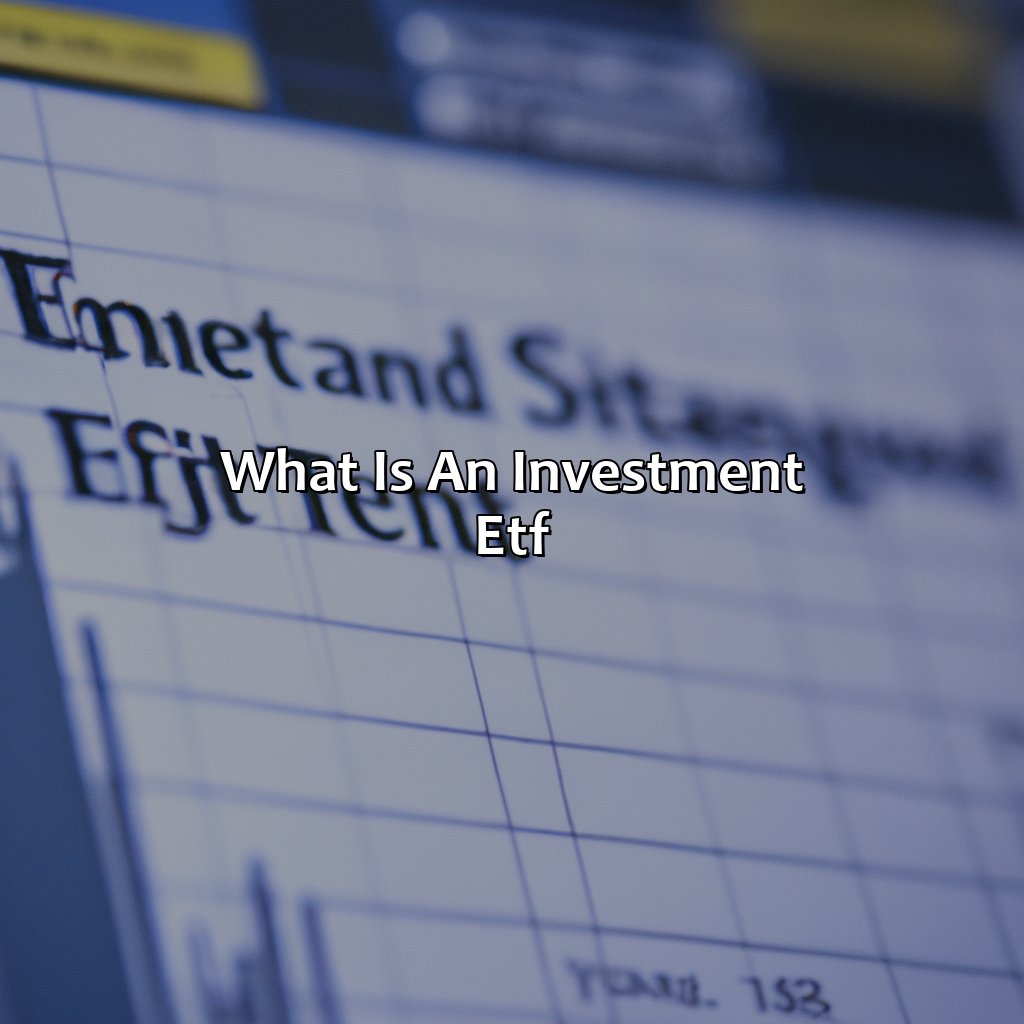What Is An Investment Etf?
Key Takeaway:
- Investment ETFs (Exchange-Traded Funds) are investment vehicles that pool investors’ money to buy a diversified portfolio of assets, such as stocks, bonds, or commodities, with the goal of tracking a specific market index or benchmark.
- Investment ETFs can offer several benefits to investors, including diversification across multiple assets, lower fees compared to actively managed funds, and easy tradability on stock exchanges, providing liquidity to investors.
- However, investors should also be aware of the risks and drawbacks of investing in ETFs, such as market risk, tracking error risk, and liquidity risk, before making a decision to invest.
Do you want to explore the world of investing but don’t know where to start? An ETF (Exchange-Traded Funds) is a great way to get started. Learn more about what an ETF is and how it can help you achieve your financial goals.
What is an Investment ETF?
To comprehend what an investment ETF is, you need its definition and how it works. This will answer your query. Two bits of information are needed to understand this: the definition of an investment ETF and how it functions. Both of these will be explained in this part.
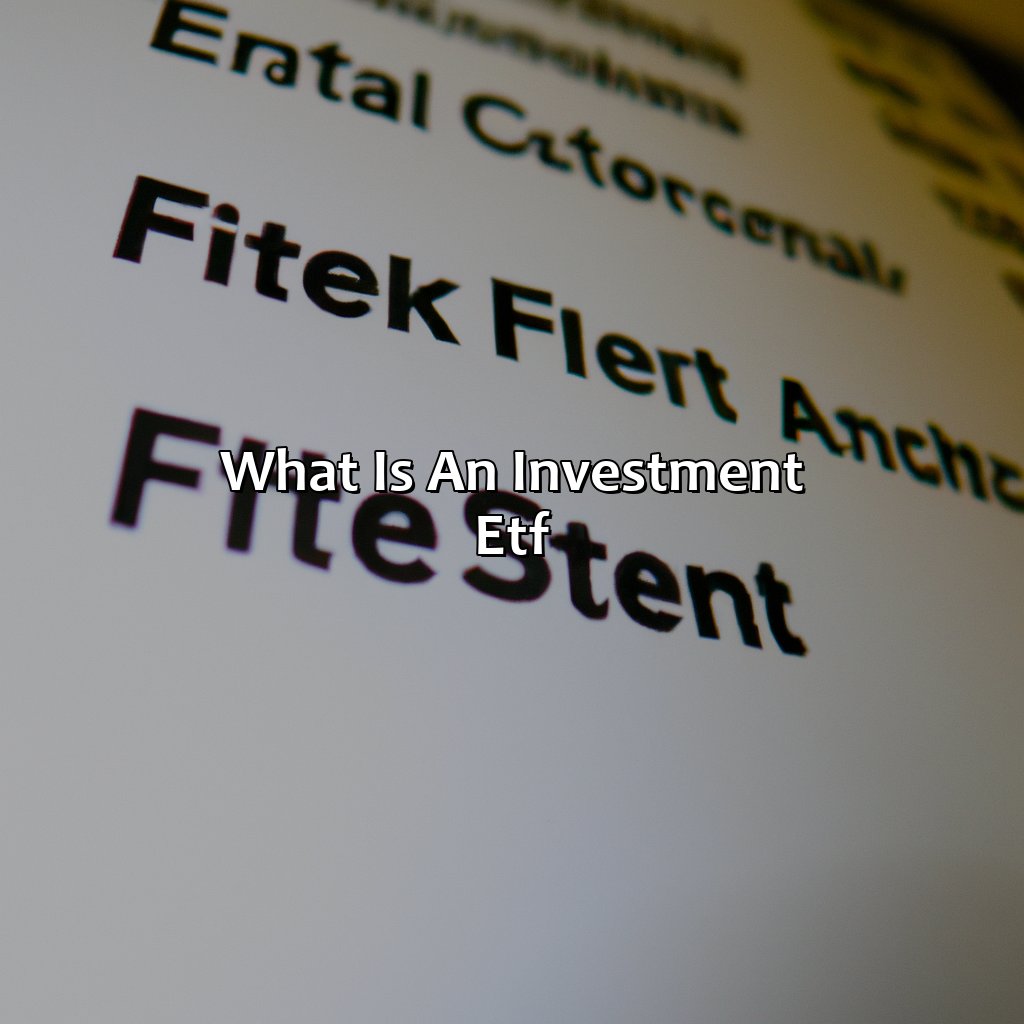
Image credits: retiregenz.com by David Woodhock
Definition of Investment ETF
Investment ETFs are types of exchange-traded funds that invest in a variety of securities, such as stocks, bonds, commodities, or currencies. They are designed to track the performance of a particular index and provide investors with low-cost exposure to specific markets. Investment ETFs can be bought and sold throughout the day on exchanges like stocks and are preferred by investors who prioritize diversification and liquidity. These funds offer flexibility and transparency in terms of investment strategies.
Investment ETFs offer an excellent opportunity for investors looking for instant diversification across different sectors and global markets with relatively low expense ratios compared to mutual funds. Moreover, they provide exposure to thinly traded asset classes that may not be accessible through traditional mutual funds. The underlying composition of these funds varies depending on the focus of the investor’s portfolio, but they typically hold a wide range of assets from various industries and geographies.
A significant advantage of investing in an Investment ETF is that they can be purchased or sold at any time when markets are open, making it easier for traders to trade shares quickly during market hours without waiting until the end of each trading day. However, despite their benefits, Investment ETFs also come with associated risks like all investments—including market risk and regulatory changes—which should be considered before investing.
Pro Tip: Before investing in an Investment ETF, it’s ideal to understand its composition by examining its sectoral and geographical reach beyond just focusing on its overall returns performance.
Why invest in a single stock when you can put all your eggs in one ETF-shaped basket?
How does an Investment ETF work?
An Investment ETF operates by pooling capital from multiple investors to purchase securities. The creation of units or shares allows for fractional ownership and liquidity, enabling trading on stock exchanges. An ETF’s value is determined by the daily market price of its underlying assets, and can also be affected by supply and demand dynamics.
Investors can trade ETFs in real-time at prices similar to those of stocks, making them a cost-effective way to diversify portfolios across various sectors, industries, regions, and asset classes. Investment ETFs may follow specific indices or strategies and utilize different types of holdings such as stocks, bonds, commodities or currencies to achieve their performance objectives.
Interestingly, not all ETFs are created equal – some have higher expense ratios than others while some offer exposure to niche areas such as green energy or emerging markets. Investors should conduct sufficient research into an ETF’s investment methodology, historical performance, fees and tax implications before investing their money.
The first-ever investment ETF was launched in Canada in 1990 by Toronto-based firm iShares Fund called “Toronto 35 Index Participation Fund,” which aimed to replicate the performance of the Toronto Stock Exchange (TSE) 35 Composite Index through a low-cost mutual fund product. Since then, investment ETFs have grown rapidly in popularity globally with over $7 trillion assets under management today.
For those who want to diversify their portfolio without the hassle of actually understanding it, there’s an ETF for that.
Types of Investment ETFs
Gain insight into the benefits and risks of various investment ETFs. Such as Equity, Fixed Income, and Commodity ETFs. Diversifying your portfolio with these can be a solution. Explore each type to see what it has to offer.
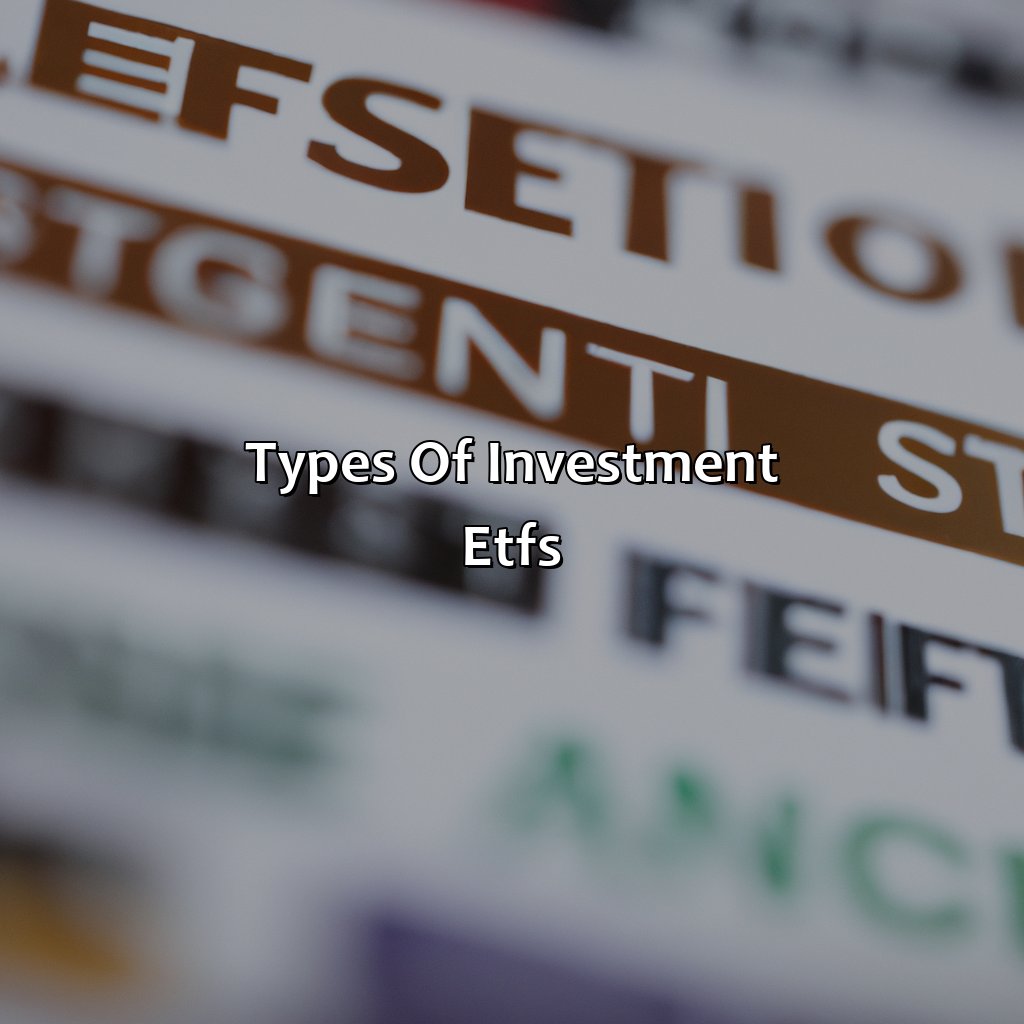
Image credits: retiregenz.com by Adam Duncun
Equity ETFs
Equities are a type of investment ETF that possess ownership in companies. Understand Equity ETFs with the following 4 points:
- These ETFs trade like a stock on exchanges and provide a diversified portfolio of equities.
- Investors can buy or sell shares throughout the trading day at market-determined prices.
- Equity ETFs track numerous industries, regions, and styles, such as dividend-paying stocks, small-cap stocks, emerging markets or technology sector.
- This type of Investment ETF is popular among traders who look for high liquidity and low expense ratio funds with exposure to the stock market’s overall performance.
Investing in Equity ETFs also gives investors benefits such as long-term capital appreciation and attractive dividend yields. It is essential to research and analyze the assets’ historical behavior before investing.
Don’t miss out on potential returns by ignoring this valuable class of Investment ETF. In today’s volatile market climate, Equity ETFs may offer an effective tool for diversification while maintaining high levels of liquidity.
Fixed Income ETFs – because nothing screams excitement like investing in bonds.
Fixed Income ETFs
Investment ETFs that follow fixed-income securities are an excellent option for investors seeking reliable sources of income. These ETFs invest in a collection of bonds, Treasury bills, and other debt instruments traded in the market. Fixed-Income ETFs usually guarantee returns with very low risk as they balance investments from a large corpus. Typically, institutional investors purchase these funds for capital preservation and regular income generation purposes.
Fixed-Income ETFs use different bonds to create an instant diversified portfolio with lower costs and fewer risks. Instead of hard work on individual bond selection, this type of investment allows investing in multiple securities simultaneously through one tradeable unit. Fixed income ETFs have tax benefits without the need to hold stocks or fixed-income securities directly.
Some specific types under this category include Corporate Bond ETFs, Municipal Bond ETFs, Treasury Bond ETFs, and Floating-Rate Bond ETFs. These are tailored towards particular risk tolerance levels and objectives while being implemented by modern algorithms that minimize expenses to achieve higher yield percentages.
According to Forbes Magazine, “As of June 2021 data, Invesco QQQ Trust (QQQ) had $170 billion assets under management (AUM), making it the largest technology-focused exchange-traded fund (ETF)”.
Commodity ETFs are like playing the lottery, except your odds of winning are slightly higher and you don’t have to scratch off any tickets.
Commodity ETFs
Investment ETFs based on commodities are exchange-traded funds that track the performance of underlying commodity assets. These commodities can include natural resources such as gold, silver, oil, and agricultural products like wheat, corn and soybeans. Commodity ETFs give investors exposure to these commodities without the need for a futures contract or physical ownership.
Some unique features of commodity ETFs include high volatility due to commodity price fluctuations and global political and economic events affecting supply and demand. In addition, these ETFs may also have tax implications due to their passive management structure.
According to a report by Statista, in 2020, the largest commodity ETF by net asset value was SPDR Gold Shares with over $70 billion worth of assets under management.
ETFs: because traditional investing is for people with too much patience.
Benefits of Investing in ETFs
Know the advantages of ETFs! To get the most from investing in them, we will discuss their benefits. Diversification, Lower Fees and Liquidity are the main topics covered for this purpose. Maximize your returns with ETFs!
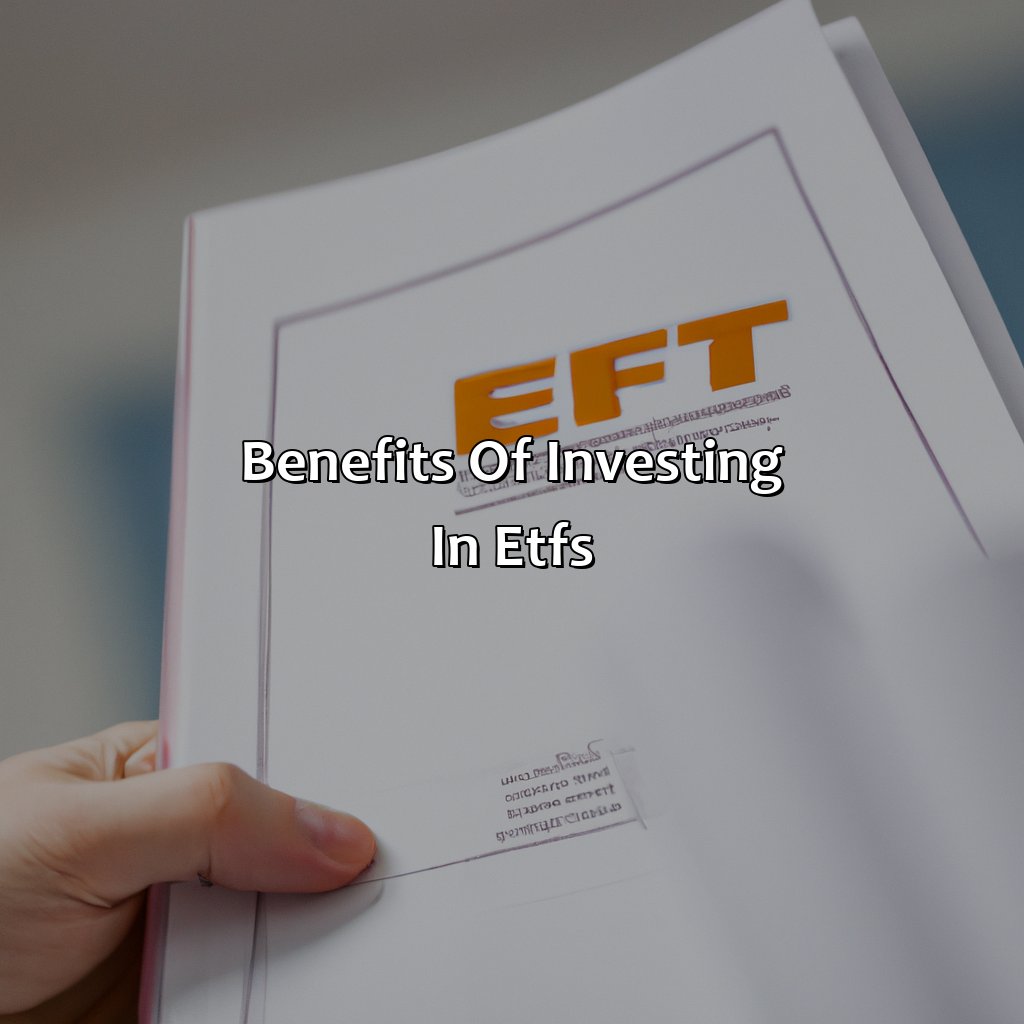
Image credits: retiregenz.com by Adam Woodhock
Diversification
Investing in a range of different assets is an effective way to reduce risk and diversify your investment portfolio. Diversification allows investors to spread their investments across various assets, including stocks, bonds, commodities and currencies. By investing in ETFs that cover a wide range of assets within these classes, you can minimize exposure to any one asset or sector and increase the likelihood of achieving more consistent returns over time.
In addition to diversifying across asset classes, investing in ETFs can provide investors with additional benefits such as lower fees than mutual funds, greater tax efficiency and ease of use. Furthermore, some ETFs allow investors to track specific benchmark indices or invest in alternative types of securities like commodities or even crypto-assets. This provides greater flexibility for investors seeking specific exposures or returns.
Investors should consider some key factors when selecting ETFs for their portfolio, such as total assets under management, expense ratios, liquidity and the overall objective of the fund. It’s important to note that while ETFs can be a relatively low-risk investment option compared to other types of securities, all investments come with some level of risk. Therefore it’s always important to seek professional financial advice before making any investment decisions.
Pro Tip: Invest regularly rather than trying to time the market or jumping into certain assets at peak prices. This disciplined approach can help you build wealth steadily over time while taking advantage of dips in the market.
Investing in ETFs is great because you get to keep more of your money, unlike that one ex who took everything in the divorce settlement.
Lower fees
The economic benefits of investing in ETFs are countless, among which is their ability to keep investment fees lower than other types of investments. Here are a few points to explain why:
- ETFs trade on exchanges like stocks hence lowering brokerage and commission charges.
- ETFs have relatively fewer management fees than traditional mutual funds.
- ETFs track indices, minimizing costs by avoiding the need for research and stock-picking.
- Their passive flexible nature saves on additional costs such as marketing activities.
- ETF trades are executed in large bulks, reducing transaction costs and spreads incurred on buying individual securities,
- ETF allows investors to buy several securities with a single purchase hence reducing spread encumbrances often associated with purchasing individual stocks.
Investing in ETFs can save an investor tens to hundreds of thousands of dollars when compared to actively managed mutual funds. The streamlined approach is valuable especially in preventing high expenses that may deteriorate long-term investment performance.
Pro Tip: Consider using commission-free brokerages that offer ETF traders limitless trading opportunities while keeping the costs low.
ETFs are like well-stocked bars – they offer a wide range of options and can be quickly liquidated when you need to call it a night.
Liquidity
Investment ETFs offer excellent liquidity, making it easier for investors to buy and sell shares. This is because ETFs trade like stocks on stock exchanges, allowing investors to easily buy or sell them at any time during trading hours.
Liquidity in investment ETFs means that there are plenty of buyers and sellers in the market, reducing the possibility of price fluctuations due to low demand. Additionally, there are many different types of investment ETFs available which reduces the risks associated with investing in just one security.
Investing in a well-diversified investment ETF increases your chances of success as it allows you to access multiple companies across various industries or sectors rather than betting heavily on just one company’s performance.
To see maximum returns from an investment ETF, consider holding it for a longer duration as opposed to short-term trades. Buying and holding an ETF over multiple years lowers trading costs while taking advantage of long-term market trends.
Not everything comes in a package deal – the drawbacks and risks of investing in ETFs.
Drawbacks and Risks of Investing in ETFs
Know potential investment ETFs pitfalls? You must recognize the risks. To prevent shocks and make smart choices, understand the market risk, tracking error risk, and liquidity risk associated with ETF investing.
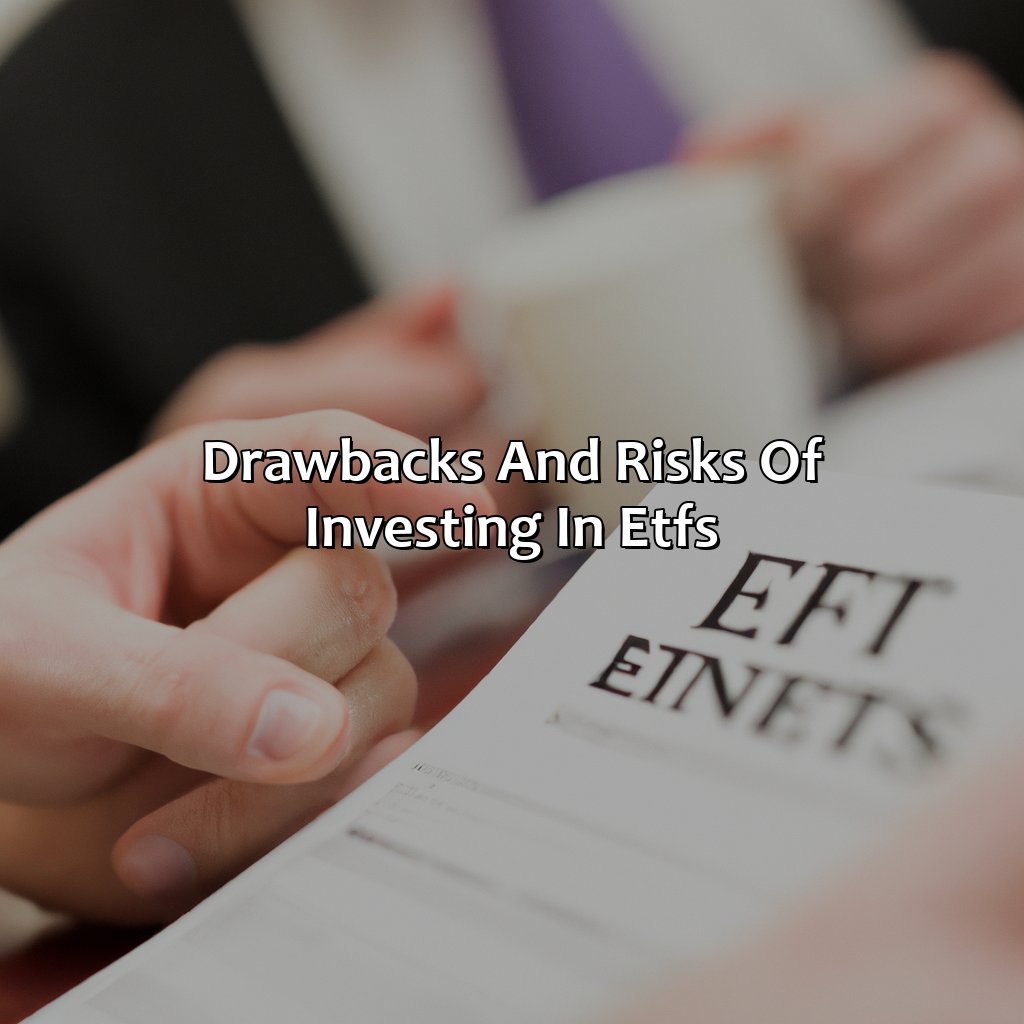
Image credits: retiregenz.com by David Washington
Market risk
Investment in ETFs may have potential market risks that can affect the value of investments. Market conditions may change all of a sudden and decrease the price of ETF shares. Moreover, some ETFs invest in highly volatile securities and if these stocks perform poorly, it will lead to considerable losses for investors too.
For instance, in March 2020, global markets experienced a sharp decline due to the COVID-19 pandemic which significantly impacted the prices of ETF shares. Some sectors even saw a reduction of up to fifty percent in value. Therefore, while investing in ETF shares, investors must carefully consider and monitor market risks given their potential effects on investments.
Don’t worry about the tracking error risk, it’s just a slight deviation from the benchmark – like a GPS that occasionally takes you to the wrong destination.
Tracking error risk
ETFs have the potential to provide low-cost and diversified investments. However, a risk associated with ETF investment is the deviation of returns from its benchmark index, commonly known as Tracking error risk.
Tracking error risk occurs when an ETF’s performance does not align precisely with its underlying index. The primary cause of this deviation is the management fees charged by the ETF provider. Investors should compare the tracking accuracy of different ETFs before investing in them.
Investors should also consider liquidity risks associated with ETFs. While some popular ETFs can be liquid and traded quickly, smaller funds or those that invest in less-liquid assets may suffer from wide bid-ask spreads and difficulty exiting a position during periods of high market stress.
To mitigate tracking error risk, investors can choose different types of ETFs such as passive and actively managed funds. Passive funds typically have a lower expense ratio than actively managed funds, but they track performance more closely to their corresponding indices rather than attempting to outperform them – which increases tracking accuracy. Actively managed funds have higher expense ratios but they aim to outperform benchmark indices by adjusting holdings more frequently than passive indexes; however, these frequent trades can increase tracking error risk.
In summary, investors must weigh the benefits and drawbacks before investing in ETFs—as they carry risks like any other investment option—and understand the unique characteristics that impact an ETF’s tracking error risk before making any investment choices.
ETFs are like Tinder matches – plenty of options, but sometimes they disappear just when you think you’ve found the perfect match due to liquidity risk.
Liquidity risk
One potential hurdle that investors need to be aware of when investing in Exchange-Traded Funds (ETFs) is the risk of losing liquidity. This can occur when the market for an ETF is narrow or illiquid, which could lead to difficulty selling shares at the desired price or volume.
Liquidity challenges may arise in several ways, such as when individual components of the portfolio become temporarily difficult to trade or during times of high market volatility. Furthermore, ETFs composed of less-liquid assets can be especially vulnerable to liquidity concerns.
As a result, investors should conduct thorough research and carefully consider each ETF’s underlying holdings before engaging in any transactions. Maintaining access to a diverse range of liquid investment vehicles can help mitigate the risks posed by particularly volatile markets.
Investors should also keep an eye on trading volumes and bid-ask spreads while carefully evaluating the impact that large trades might have on market prices. Building a robust trading strategy with stop-loss orders and regularly rebalancing portfolios can offer additional protections against liquidity risks.
In summary, while ETFs present many opportunities for investors looking to diversify their portfolios, it’s critical not to overlook the risks they pose-individual funds will carry varying degrees of liquidity hazards. By researching investments thoroughly and keeping a close watch on market conditions, investors will be better positioned to make informed decisions that support long-term investment objectives.
Some Facts About Investment ETF:
- ✅ An Investment ETF is a type of exchange-traded investment fund that invests in a basket of assets, such as stocks, bonds, or commodities. (Source: Investopedia)
- ✅ ETFs trade on public stock exchanges and can be bought and sold like individual stocks. (Source: CNBC)
- ✅ Investment ETFs provide investors with diversification, flexibility, and transparency. (Source: The Balance)
- ✅ There are various types of Investment ETFs, such as equity ETFs, bond ETFs, sector-based ETFs, and international ETFs. (Source: Fidelity)
- ✅ Investment ETFs have lower expense ratios compared to mutual funds, making them more cost-effective for investors. (Source: Forbes)
FAQs about What Is An Investment Etf?
What is an investment ETF?
An investment ETF (Exchange-Traded Fund) is a type of investment fund that tracks a specific index, sector, commodity, or other asset classes. It is similar to mutual funds but can be traded like individual stocks on a stock exchange.
How does an investment ETF work?
When you invest in an investment ETF, you are buying shares that represent a portion of the total assets held by the ETF. The ETF is designed to track the performance of a specific index or asset class, and its value fluctuates in line with the underlying assets. The ETF is managed by a fund manager, who ensures that the fund keeps pace with the index or asset class it tracks.
What are the advantages of investing in an ETF?
Investing in an ETF has several advantages, including diversification, lower costs, and greater transparency. ETFs allow you to invest in a basket of securities, which reduces your exposure to risk and volatility. They also have lower fees compared to mutual funds, and their holdings are disclosed on a daily basis, which makes it easier to monitor their performance.
What are the risks of investing in an ETF?
Although investing in an ETF can be less risky compared to individual stocks, there are still some risks involved. ETFs are subject to market fluctuations, meaning that the value of your investment can go up and down. Additionally, some ETFs may have hidden costs, such as brokerage fees or tracking errors, which can affect their overall returns.
How can I invest in an ETF?
Investing in an ETF is relatively simple. You will need to open a brokerage account with a reputable broker and fund the account. Once you have funded your account, you can search for the ETF you want to invest in and purchase shares through your brokerage account.
Can I trade an investment ETF like a stock?
Yes, you can trade an investment ETF like a stock. ETFs are traded on a stock exchange, which means that you can buy and sell them during market hours just like you would with individual stocks. However, it is important to note that frequent trading can lead to higher costs and may affect the overall performance of your investment.
